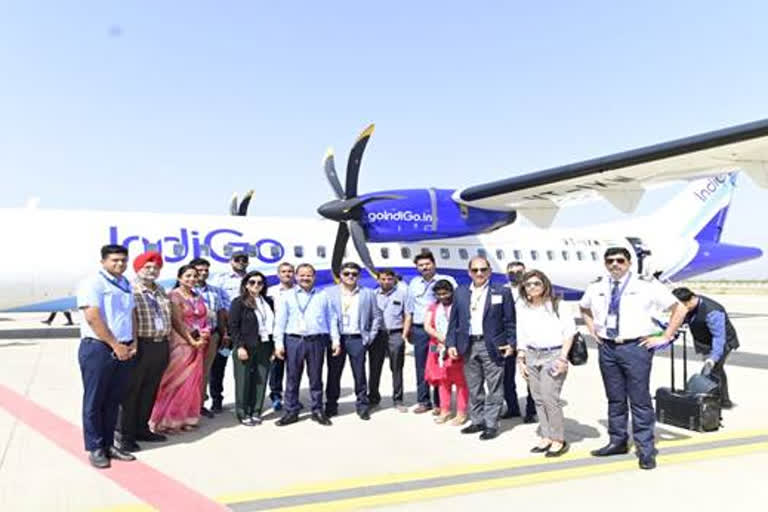New Delhi: India on Thursday created history as it used its locally developed satellite-based navigation system GAGAN for the landing of a flight in the western state of Rajasthan. Officials from the Airport Authority of India successfully conducted flight trials using the GAGAN-based landing of an IndiGo flight at Kishangarh Airport near Ajmer in Rajasthan. With this feat, India became the first country in the Asia-Pacific region to achieve such a landmark.
The IndiGo flight used GAGAN (GPS Aided GEO Augmented Navigation) based landing known as Localizer Performance with Vertical Guidance (LPV) Approach Procedures. Officials said it’s a major milestone in the field of Air Navigation Services (ANS) in the history of the Indian Civil Aviation Sector.
What is Localizer Performance with Vertical Guidance?
Localizer Performance with Vertical Guidance (LPV) permits aircraft-guided approaches that are operationally nearly equivalent to CAT-IILS, without the need for ground-based navigational infrastructure.
The service relies on the availability of GPS and GAGAN Geostationary Satellites (GSAT-8, GSAT-10, and GSAT-15), launched by India’s state-owned space research organization ISRO.
What is GAGAN Navigation System?
GAGAN is an Indian Satellite-Based Augmentation System (SBAS) jointly developed by the Airport Authority of India and ISRO. This is the first such system developed for India and neighboring countries in the equatorial region.
GAGAN System was certified by India’s civil aviation sector regulator – the Directorate General of Civil Aviation (DGCA) in 2015 for Approach with Vertical Guidance (APV 1) and en-route (RNP 0.1) operations.
There are only four Space-Based augmentation systems available in the world. These are India’s GAGAN system, the WAAS system of the USA, Europe’s EGNOS, and Japan’s MSAS. GAGAN is the first such system developed for India and neighboring countries.
IndiGo flight uses GAGAN based navigation
IndiGo, India’s largest airline in terms of fleet size and the number of passengers served, using its ATR aircraft has flown an Instrument Approach Procedure (IAP) with LPV minima of 250ft, using GAGAN Service.
The tests at Kishangarh Airport were performed as part of initial GAGAN LPV flight trials with the DGCA officials onboard. After the final approval by the DGCA, the procedure will be available for use by other commercial airlines.
LPV based landing useful for smaller airports
LPV is a Satellite-Based Procedure that has been used by the aircraft for landing purposes today at Kishangarh Airport in Rajasthan.
LPV approaches will make it possible to land at airports not equipped with expensive Instrument Landing Systems, which include many small regional and local airports.
Lowering the decision height up to 250 feet provides a substantial operational benefit in poor weather and low visibility conditions. According to officials, any airport that until now required higher visibility will be able to accept aircraft benefitting remote airports which do not have precision approach capability equipment.
A number of airports including airports under the Regional Connectivity Scheme (RCS) are being surveyed for the development of GAGAN based LPV Instrument Approach Procedures so that properly equipped aircraft can benefit in terms of improved safety during landing, reduction in fuel consumption, reduction in delays, diversions and cancellations, among other things.
GAGAN’s utility in Ocean, Railway & Mining services
Airport Authority of India and the Indian National Centre for Ocean Information Services (INCOIS) have jointly implemented the GAGAN Message Service (GMS) through which alert messages to fishermen, formers, and disaster-affected people will be sent on the occurrence of natural disasters, calamities, such as flood, and earthquakes.
The additional capabilities of GAGAN are also being explored to utilize it in non-aviation fields such as Railways, Surveying, Agriculture, Power sector, Mining, etc.
Officials said the design of GAGAN procedures requires an in-depth survey of the airport environment surroundings and obstacle surfaces. These data are correlated with the complex aircraft approach maneuvers and further simulated in software to ensure the safety of the procedure.
These procedures can be developed for any of the airports in India for landing without the help of an Instrument-based Landing System.
These types of procedures make aircraft land in low visibility conditions almost equivalent to Category-1 Instrument Landing System (ILS).
More than 75 aircrafts capable of LPV based landing
At present, IndiGo has 35 aircraft, SpiceJet has 21 aircraft, Air India which has been recently acquired by Tata Sons has 15 aircraft, while Go First has 4 aircraft, and Air Asia Asia has one aircraft that can use these LPV procedures for landing purpose. Some other aviation services also have aircrafts capable of using the LPV-based landings.
According to officials, the Airport Authority of India has developed 22 such procedures and some are under process of approval from DGCA for commercial flight operations. Authorities are also developing LPV procedures for all civil airports in the country to make the Indian civil aviation sector more self-reliant.
In a statement, the civil aviation ministry said the Airport Authority of India is working to ensure the availability, continuity, and integrity of Air Navigation Services by developing indigenous technology. With this India becomes the first country in Asia to have a satellite-based landing procedure.



